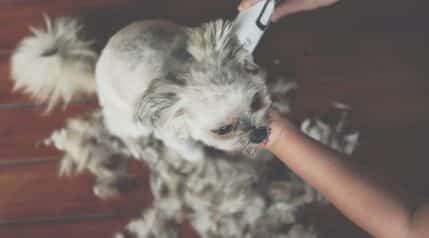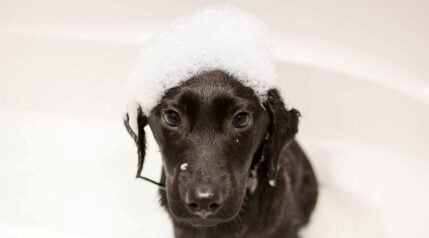Labradoodles are one of the most popular doodle crossbreeds in the entire world. They are beloved by many pet parents for their easy-going nature. They have great temperaments, and usually get along well with children, as well as other household pets.
However, something that many potential Labradoodle owners struggle with is understanding just how much they shed. Do Labradoodles shed? Yes. In fact, there is no such things as a completely hypoallergenic dog. Labradoodles do shed less than other breeds, and there are also ways to manage their shedding so that it doesn’t become a nuisance in your home.
In this article, we look at how much Labradoodles shed, their coat types, how their coat colors can impact the fur visibility they leave behind, and finally, the easiest ways to keep shedding in check so it doesn’t dominate your home. Let’s jump in!
Labradoodle Coat Types

Labradoodles can sport a variety of coat types. This will largely vary on if they are an F1 or an F1B Labradoodle. Their coats can be wiry, thick and curly, or silky soft to the touch. They are a single coated dog, meaning they don’t have an undercoat.
This means they shed less and their coats will be easier to manage than other breeds, like their Labrador Retriever parent. Their lower-shedding coat is mostly inherited from their poodle parent, which is more well known as a lower-shedding dog that’s great for allergy sufferers.
Coat Colors
The Labradoodle can have many different colors, inherited by both parent breeds. The most common coat colors are golden, golden red, brown, white, and even black. This is true regardless of their size, and meaning even Mini Labradoodles will have a similar coat color palette.
They can also have many different coat hues including different shades of browns, grays, reds/browns depending on the parent’s genetics. The more dominant breed in their bloodline can help determine what type of coat color they ultimately develop.
Their coat color is important because it allows dog owners to potentially match their furniture to their dog’s coat color. If you have a brown couch, and a brown dog, you’ll be far less likely to see any dog fur left behind.
Shedding Frequency
While they do shed more than compared to a Poodle, Labradoodles shed less than other purebred dogs, and other mixes. You can expect your dog to shed daily, just in less noticeable amounts. This means you should expect at least a weekly vacuum, sweeping, or cleanup.
You may also have some fur leftover on your furniture or carpet that you’ll want to attend to, depending on the color of your dog, and the color of your furniture. Having a supply of lint rollers along with your vacuum can help keep fur off your furniture!
Because they aren’t seasonal shedders, you can expect them to shed about the same amount year round. The only time you may experience more hair loss than normal is in certain situations, which we will look at next.
Shedding Triggers

There are several possible shedding triggers that may make your Labradoodle shed more than normal. It’s quite common to see any dog shed under stressful situations, if they have skin conditions, or if there’s some type of seasonal allergy to a plant or grass in your home. Let’s look at each.
Stress
Stress is a very common reason that dogs shed. Both stress and anxiety can cause fur loss due to several factors. Labradoodles can become very attached to their humans. This means they can become stressed and anxious if they are left at home for longer periods of time.
If you work full time outside the home, it may cause separation anxiety in your pup, which in turn, can lead to stress-induced shedding. Changes in your dog’s routine can also cause stress that leads to shedding.
Labradoodles may also shed due to changes in their social environment. If your dog isn’t used to being around other dogs, it’s possible that they will start shedding if you decide to introduce a new dog to your pack at home.
This type of stress-related fur loss usually won’t last more than two weeks and then the coat should return to normal without any intervention. If stress-induced shedding doesn’t resolve after a few weeks, you’ll want to consult with your veterinarian about the best way to manage it.
Allergies, Fleas, and Parasites
Believe it or not, dogs can be allergic to grass, and other potential plant-based skin irritants. This can cause them to shed more during certain times of year, even though they are single-coated dogs. Pay attention to when you notice your Labradoodle shedding, especially if it only happens during certain times of year.
Fleas, and parasites are also common occurrences that may cause your dog to start shedding more than normal. Fleas will be more visible, and easy to identify as a cause of fur loss. They are also quickly treated by topical or oral medications. Parasites will need to be diagnosed by your veterinarian.
Skin Infections
Skin infections are common in dogs and can cause skin irritation and shedding. A common example of this is yeast dermatitis, which occurs when the natural acidity in your dog’s skin gets too high or low due to factors like diet changes, antibiotics use, illness, and allergies. It’s important to note if fur loss starts after any one of these changes in your dog’s routine.
Managing Your Labradoodle’s Shedding

While they do shed, there are actually some fairly easy steps to controlling their fur loss! Labradoodles have lower grooming needs than other breeds due to the consistency of their coats. You’ll find that you have to do the following far less than with other heavy-shedding dog breeds.
Brushing
It’s always a good idea to regularly brush your dog. Labradoodles are no different. This mix will need weekly brushing, unlike their Labrador Retriever parent, who will need it daily. Expect to spend around 20 minutes per week brushing your pup. This mix typically won’t require an undercoat rake, unless you let their fur grow significantly longer than normal.
Bathing
You’ll want to find the right shampoo formula for your Labradoodle. This mix is known to have sensitive skin. So you’ll want to stick to a sensitive skin shampoo for dogs or consider a formula with colloidal oatmeal. This should help your pup’s skin stay soft and moisturized, no matter the weather conditions.
Make sure you aren’t bathing your dog more than one time every 8 weeks or so. This will dry out their skin, which can upset the pH balance of their coat, which in turn, will increase the amount they shed!
Diet
Diet plays a key role in making sure your Labradoodle has the nutrients that they need to keep their skin and coat healthy. You’ll want to feed your pup a high-quality dry kibble, that will meet all their nutritional needs. Most Labradoodle-approved dog food formulas are rich in Omega-3 and 6 fatty acids, which will help support their skin, and coats. This can help reduce shedding over time.
Supplements
While you shouldn’t rely on supplements to fill your dog’s nutritional needs, adding a fish oil or Omega fatty acids supplement to your Labradoodle’s diet definitely won’t hurt. You can find fish Omega fatty acid supplements in pill form, treat form, or as a liquid that you can use on their dog food to make it tastier than normal.
Frequently Asked Questions
Why is my labradoodle shedding more than normal?
As mentioned above, there could be many reasons that your pup is shedding more than normal. You'll want to rule out any potential stressors, which includes life or routine changes. Also, make sure that their diet wasn't changed recently. If you can rule those out, contact your veterinarian for advice.
How can I prevent my labradoodle from shedding?
Regular brushing and grooming maintenance will help keep shedding to a minimum. You'll need to make sure you are brushing your pup at least once per week, and washing them no more than once every eight weeks.
Are labradoodles shed-free, or hypoallergenic?
No dogs are shed-free. Even the Chinese Crested (hairless dog) can shed. Anyone saying that a dog is truly hypoallergenic, isn't accurate. Labradoodles do shed far less than other dogs, including their purebred Labrador parents.
Do F1 or F1b labradoodles shed more?
F1 Labradoodles in theory, have a greater chance to shed than an F1b. This is because there's a chance an F1 (first generation) takes more after their Labrador parent's shedding habits. F1b's are one generation removed, which means they should shed less as they are more "doodle" at that point.
Final Thoughts
Labradoodles do shed. But they are also a beautiful mixed breed that comes with the responsibility of grooming, just slightly less than other dogs. If you take care of your Labradoodle and invest in tools to keep their coat healthy, they’ll be happy and well-groomed for years to come. Your home will also be blissfully fur-free, especially when compared to other heavy-shedding pups!





